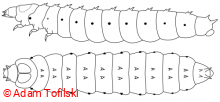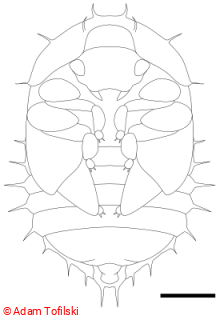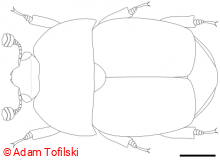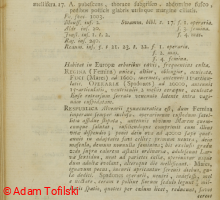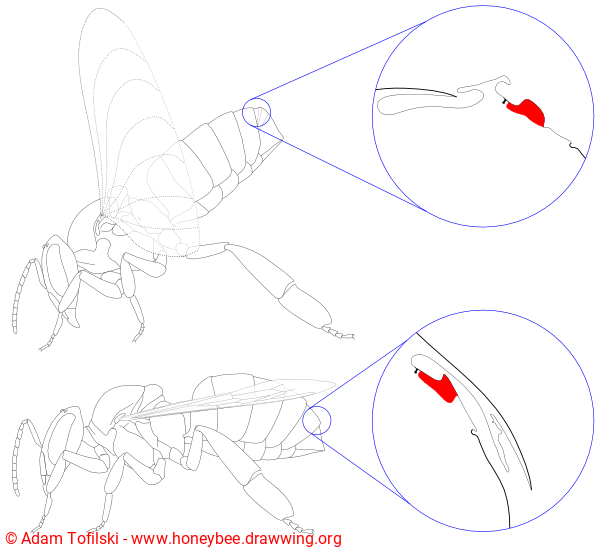
Nasonov gland (marked red) of honey bee worker. After Jacobs (1925, fig. 12a, 21b) Das Duftorgan von Apis mellifica und ähnliche Hautdrüsenorgane sozialer und solitärer Apiden,
, Volume 3, p.1-80, (1924)
[1], Snodgras (1956, fig. 57c) Anatomy of the honey bee,
, Ithaca, p.334, (1956)
[2].
In the upper image the gland is exposed; in the lower image the gland is hidden between tergites.
The Nasonov gland is exposed by: workers forming swarm cluster Pheromone concert in swarming honey bees,
, Volume 64, p.1414-17, (1971)
[3], young workers returning from orientation flight De Luchtverversching van een Bijenkast gedurende den zomer,
, Volume 44, p.1-16, (1941)
[4], foragers at a food source Reward rate and forager activation in honeybees: recruiting mechanisms and temporal distribution of arrivals,
, Volume 54, p.80-87, (2003)
[5], returning foragers when they have problem with finding the nest entrance The adaptability of the homecoming honeybee,
, Volume 1, Number 2, p.59–66, (1953)
[6], disorientated workers outside the nest A scent organ in the bee,
, Volume 29, p.151-153, (1901)
[7], workers waiting at the nest entrance for queen returning from mating flight The mating of the honeybee,
, Volume 3, p.2-15, 23-24, (1956)
[8], worker at the nest entrance of queenless colonies Pheromones of social bees,
, London, p.218, (1987)
[9], near larvae chosen for emergency queen rearing The Nasonov Gland Pheromone is Involved in Recruiting Honeybee Workers for Individual Larvae to be Reared as Queens,
, Volume 25, Issue 4, Number 4, p.392-400, (2012)
[10], workers in some unnatural circumstances The behaviour of worker honeybees at the hive entrance,
, Volume 4, p.262-292, (1952)
[11].
Nasanov gland occurs only in workers, not in queens or drones.
The Nasonov gland secretion contains (accordng to The attractiveness of citral to foraging honeybees,
, Volume 2324, p.1-7, (1964)
[12]Identification of geraniol as the active component in the Nassanoff pheromone of the honey bee,
, Volume 194, p.704-706, (1962)
[13]Identification of nerolic and geranic acids in the Nassanoff pheromone of the honey bee,
, Volume 202, p.320-321, (1964)
[14]Nasonov pheromone of the honeybee Apis mellifera L. (Hymenoptera: Apidae), I. Chemical characterization.,
, Volume 6, p.425-434, (1980)
[15]):
- (Z)-citral
- (E)-ditral
- nerol
- geraniol
- nerolic acid
- geranic acid
- (E,E)-farnesol
Each of the components separately is not as effective as the mixture Attractant or pheromone: The case of Nasonov secretion and honeybee swarms,
, Volume 25, Number 9, p.2051–2056, (1999)
[16].
Composition of the secretion changes with age of workers Production of geraniol by honey bees of various ages,
, Volume 9, Number 4, p.431–434, (1963)
[17] and differs between winter and spring Nasonov pheromone of the honeybee, Apis mellifera L. (Hymenoptera, Apidae), III. Regulation of pheromone composition and production,
, Volume 7, p.543-554, (1981)
[18].
Synthetic Nasonov pheromone can be used to attract swarms to swarm traps Synthetic pheromones to attract honeybee (Apis mellifera) swarms,
, Volume 97, p.427–431, (1981)
[19]Baits to improve bait hive attractiveness to honey bees,
, Volume 123, Number 3, p.193–194, (1983)
[20]Honeybee Nasonov pheromone lure,
, Volume 65, p.175-181, (1984)
[21]Using synthetic pheromone lures to attract honeybee colonies in Kenya,
, Volume 25, p.85–86, (1986)
[22]Swarm traps for survey and control of Africanized honey bees,
, Volume 33, Number 3, p.155–158, (1987)
[23]Attraction of reproductive honey bee swarms to artificial nests by Nasonov pheromone,
, Volume 20, Number 5, p.1053–1056, (1994)
[24]Attractant or pheromone: The case of Nasonov secretion and honeybee swarms,
, Volume 25, Number 9, p.2051–2056, (1999)
[16], attract bees to crops for pollination Attracting honeybees to alfalfa with citral, geraniol, and anise,
, Volume 9, p.9-12, (1970)
[25]The effect of citral and geraniol conditioning on the searching activity of honeybee recruits,
, Volume 12, p.53-57, (1973)
[26]The Nasonov pheromone of the honeybee, Apis mellifera L. (Hymenoptera: Apidae), II. Bioassay of the components using foragers,
, Volume 7, p.225-237, (1981)
[27].
Other references: La glandola odoripara dell'Apis mellifica L,
, Volume 24, p.53-66, (1960)
[28]A synthetic pheromone lure to induce worker honeybees to consume water and artificial forage,
, Volume 22, p.224-228, (1983)
[29]Effect of honeybee Nasonov and alarm pheromone components on behaviour at the nest entrance,
, Volume 22, p.214–223, (1983)
[30]
- Log in to post comments
- Log in to post comments

